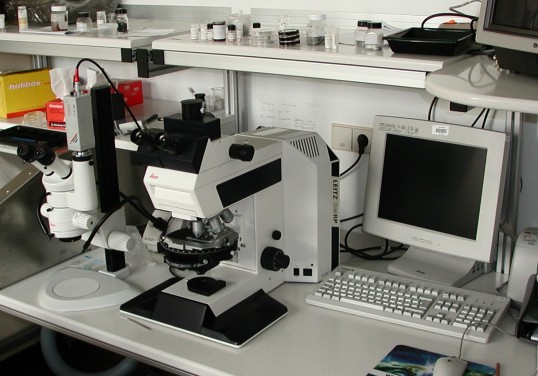- Missions of the IFA
- Fields of activity
- Organisation
- How to find us - Address - E-Mail
- Impressum
Dusts - Fibres

Stereo and phase-contrast microscope for identifying asbestos with coupled digital image capture
Source: IFA
In this section of the Chemical and Biological Hazards Department, two working groups analyse atmospheric and material samples for dusts and their mineral constituents and for fibres.
Dusts
The focus of the work lies upon determining the concentration of respirable, inhalable and wood dusts by weighing. The following substances are detected individually in the dusts: quartz (by X-ray diffraction and Fourier transform infrared spectroscopy - FTIR), diesel-engine emissions (by coulometry), and amorphous silicic acids and talc (by FTIR). In addition, X-ray diffraction is used for the analysis of cristobalite, tridymite, silicon carbide and graphite. Sedimentation analyses and laser granulometry are used to determine the particle-size distributions and proportions of defined particle fractions of material samples and settled dusts. The qualitative composition of settled dusts is analysed by means of phase-contrast microscopy techniques and determined in combination with qualitative FTIR and X-ray diffraction analyses.
Fibres
Measurement of the concentration of respirable fibres (WHO fibres: length > 5 µm, diameter < 3 µm, length-to-diameter ratio > 3:1) by means of scanning electron microscopy (SEM) and optical microscopy constitutes the main function of the working group. SEM EDX analyses are used to identify asbestos, mineral wool, aluminium silicate, aluminium oxide, silicon carbide and talc fibres, and to determine their concentrations. A catalogue of criteria has been developed for identification and differentiation of asbestos and other fibres in mineral raw materials and has now been incorporated into the body of technical regulations. Product fibre concentrations of a range of inorganic fibres are also determined. Material samples are analysed for asbestos and other types of fibre for the assessment of a potential asbestos hazard during redevelopment work.
In addition to this area of activity, methods have been developed in recent years for the quantification of toner particles in air (phase contrast microscopy) and for determining the concentration of carbon nanotubes (SEM EDXA).
More information
Publications on

Dust (PDF, 376 kB, non-accessible) 2
- Definitions (PDF, 145 kB, non-accessible) 1
- Sampling, analysis (PDF, 220 KB)
- Respirable dust, inhalable dust1
- Wood dust (PDF, 64 KB)
- Soluble portion ( Method (PDF, 220 kB, non-accessible) 2 , Significance1 )
- Concentration1
Diesel engine emissions (Coulometry)1
Fibers (Scanning electron microscopy (SEM), Phako)1
- Material samples1
- Mineral raw materials (General1, TRGS 517 (PDF, 143 kB, non-accessible) 2)
- Identification1 (Software1)
- Talc powder (PDF, 253 kB, non-accessible)
Carbon nanotubes (CNT) (PDF, 1.4 MB, non-accessible)
1 in German
2 Summary in English
(published in the journal Gefahrstoffe - Reinhaltung der Luft - Air quality control and other media)
Contact:
Chemical and biological hazards
Tel: +49 30 13001 3230Fax: +49 30 13001 38001